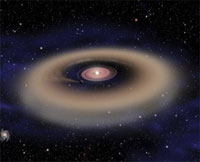 A huge star, 265 times the mass of our sun, was recently discovered. Is that as big as it gets?
A huge star, 265 times the mass of our sun, was recently discovered. Is that as big as it gets?
To most people, stars are those twinkling little lights that shine way up in the night sky. If you have ever spent a night under a truly dark sky you may be stunned to see how many there really are.
It’s estimated that there are more stars in the Universe than there are grains of sand on the Earth. Stars are plentiful in the Cosmos, but what of their sizes?
A huge star, 265 times the mass of our sun, was recently discovered. Is that as big as it gets?
To most people, stars are those twinkling little lights that shine way up in the night sky. If you have ever spent a night under a truly dark sky you may be stunned to see how many there really are.
It’s estimated that there are more stars in the Universe than there are grains of sand on the Earth. Stars are plentiful in the Cosmos, but what of their sizes?
With seemingly billions of them it’s reasonable to think that there would be a vast range of sizes, from some smaller than Earth to others that dwarf our own star, the sun. But is there an upper limit to how big a star can be?
billions of them it’s reasonable to think that there would be a vast range of sizes, from some smaller than Earth to others that dwarf our own star, the sun. But is there an upper limit to how big a star can be?
Until recently, astronomers thought there was an upper limit equivalent to 150 times the mass of the sun. This measure was set through observation by the Hubble Space Telescope and other observational projects. But a recent study of a star called R136a by a team led by Prof. Paul Crowther, of the
The star, found in a gargantuan cluster called R136, weighs in at a mammoth 265 times the mass of the sun and is thought have been around 320 solar masses at its formation.
What is it then that determines the maximum size of a star and what is this maximum limit now thought to be?
First, let’s look at what controls the physical size of a star. There are two forces that control this, the force of gravity (a pulling force) and the radiation force (a pushing force)
Inside a mature star -- a vast ball of hot gas called “plasma” -- hydrogen nuclei crash together at a phenomenal rate and form helium nuclei. In doing this, they give off heat and light.
By emitting this energy, pressure pushes outward -- this is called “radiation pressure.” The upshot of all of this is that the force of gravity tries to collapse a star and the radiation pressure tries to blow it apart!
During the mature stage of its life, the two forces balance out and the star remains a stable size. There are however lots of complex variations to this that determine the actual size of a star and it changes throughout a star’s life.
A series of imbalances occur throughout its lifetime, which lead to the star swelling or shrinking in size. Of more importance (and of use to science) is the identification of material in the star and its mass. It’s the latter that has caused all the controversy.
“During the early history of the Universe there were probably many more supermassive stars,” Prof. Crowther told Discovery News. “Star formation occurs from the gravitational collapse of huge clouds of gas and dust.”
“If that cloud is cool, then smaller stars tend to form but if the cloud is warm, we get larger stars. The crucial ingredient is carbon monoxide which acts as a cooling agent in the cloud but in the early Universe, carbon monoxide didn't exist.”
Crowther went on to explain that he believes the real process that limits star sizes is competition.
“Stars form through gravitational collapse in gas clouds but this process allows for the creation of more than one star,” he said. “In these star clusters, which are stellar nurseries, there is competition for the material, and it's this competition that seems to limit the amount of material any star can grab.”
“This may be the real cap on the amount of material found in any single star, which leads us to believe that something around 300 times the mass of the Sun is the ultimate limit in today's Universe.”
So we seem a little closer to understanding what limits the size of a star and according to current theory, that limit has now doubled in size. What is perhaps most surprising is that the maximum size a star can possibly be changes as the Universe evolves.

 Previous page
Previous page Back to top
Back to top







